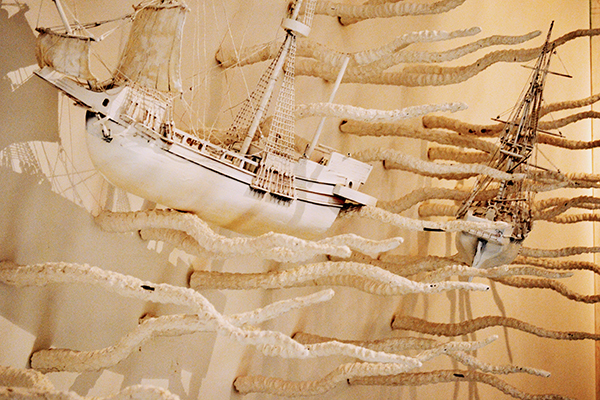Just keep swimming, just keep swimming
The sea theme is prominent across the entire exhibition, but the variety of mediums Prujean and Wedde use results in a textured and innovative visual display. The sound of rushing water, courtesy of Wedde’s turbine, chest and dive video titled “Biomorphic artifact #1”, produces a highly visceral underwater atmosphere. Miniature video interfaces sit beside sculptures reposing on the floor and suspended from the wall, with the odd painting thrown in for good measure. While it would have been easy for these paintings to be obscured by the sculptures, which are initially more attention-grabbing due to their three-dimensionality, they hold their own via lively colour palettes and curious subject-matters. Curious, because while they certainly depict underwater scenes, they do so through a unique process of defamiliarisation. “Oil Lamps and Moby Dick” is intriguingly self-explanatory: it depicts a giant whale emerging out of the sea, surrounded by multiple long-stemmed oil lamps bobbing in the water. Why? I have no idea, but it looks pretty damn awesome.
Another pretty damn awesome work is “The Node of Inaccessibility”. It appears to depict a giant blue egg-shaped object from a distance, but approach the painting and you witness hundreds of tiny boats and ships moving busily over the surface of the so-called egg. That several of these ships are actually falling off the curved edges recalls the Middle Ages-era assumption that if you travelled too far by sea you would literally fall off the edge of the world. Thus, the egg comes to signify a parallel earth – one without a land mass, completely covered by water. I’ll correct my earlier sentiment, and say that this is one terrifying aspect of the exhibition.
Another memorable piece is the “Call of Cthulhu” ceiling display. I say display, but what I actually mean is REMOTE-CONTROLLED TENTACLES. Okay, not really remote-controlled, but they do wave alarmingly in your face thanks to some kind of electronic contraption. With the sloshing sounds of the water soundtracking the exhibition, they too contribute to a surprisingly realistic underwater effect. Meanwhile, the “Escape the Greyness” sculpture is perhaps the most whimsically delightful artwork of the exhibition, depicting an intriguing semblance of seaweed draped over a rock with a combination of plastic milk bottles, silicone, cement, and LED lights.
Possibly one of the most original exhibitions I’ve reviewed this year, Deep Sea Dis-comedusae presents the viewer with a familiar theme and inverts this familiarity in a simultaneously surprising and compelling way. Whether you love sea creatures or recoil from them like yours truly, it’s definitely worth a look-in.
Deep Sea Dis-comedusae (Hayden Prujean & Carlos Wedde)
Blue Oyster Gallery29 August – 29 September 2012



